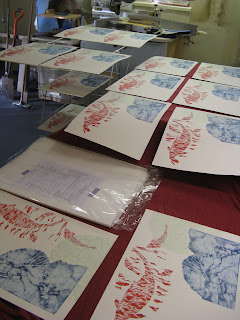I have recently participated in another couple of collaborative print projects and I wanted to share what I think are some of the benefits of taking part in these sorts of events.
Firstly, here is an outline of the projects I have been involved with recently:
SGCI Themed portfolio
Last year I took part in a collaborative project which involved creating a portfolio of works that have been sent to the SGCI Conference -FLUX, in Portland, Oregon, The conference is taking place March 30- April 2nd this year. You can read more about this project here.
50 hour Print Marathon
to celebrate 50 years of the Print Council of Australia.
This was organised in New Zealand by Toni Mosley of Blue Bathtub Press in collaboration with Simone Tippett of Union Street Printmakers in Adelaide and took place over 50 consecutive hours at Nathan Homestead, NZ and at four locations in Adelaide, Australia.
Each group produced 50 themed monoprints. Participants dropped in during the 50 hours and worked on parts of several prints at a time.
The focus was on building communities, having fun, experimentation, play, and collaboration.
25 prints from each city will be swapped with the other and, later in the year, each city will exhibit their 25 prints alongside the other city's prints. All prints will be for sale and commemorative zines will also be available.
Several members of my print group,Waitakere Printers Ink, went along to take part and it was fun working alongside, sharing ideas and freaking out at the challenge of working on top of someone else's work, while in full view of others! No hiding behind closed doors or chucking your cock ups in the bin!
 |
| Toni Mosley (right) of Blue Bathtub Press |
 |
| A selection of some of the prints. |
50 printmakers produce 5 collaborative prints
also to celebrate 50 years of the Australian Print Council.
For this project there are 5 groups of 10 printmakers.
Each group will produce an edition of 12-14 prints.
Each printmaker will receive a final print that their group has produced.
One print from each group will be sent to the Print Council of Australia to be exhibited under the umbrella of the Print Council of Aotearoa New Zealand.
I have just completed my part in this (phew) and so now I can rest easy and watch as it moves around the country, being added to by 7 more printmakers.
So, why do I think collaborative projects are good for your growth as an artist, and why should you participate if you get the chance?
- meet other like-minded artists - you may meet people who will become life-long friends, mentors or even fans of your work!
- build communities of like-minded artists for support, inspiration and future opportunities,
- share knowledge and ideas - see how others work and have the opportunity to discuss ideas for ways of working or approaching problems. I've learnt new tricks and tips that I can add to my arsenal and I love to share what I've learnt along the way,
- have the opportunity to work in a way that you wouldn't normally work - it opens you up to try new things and explore new ideas,
- share the trials and the tribulations of a project - you may think that you are the only one fretting over what you will do and how you will achieve it but, actually, you're not alone - even the artists you look up to are probably quietly fretting over the same things: will I stuff it up?, what if no-one likes what I've done?, what if I leave smudges?....
- let go of your ego - there's no room for ego in a collaborative project - it's about a shared experience, mutual respect for everyone involved and mutual reward for the results. This can be a freeing, and at times, challenging experience,
- because you don't have control of the project (no-one does) you never know where it will end up and what will be revealed along the way - I find this really exciting and completely different from how I used to work where everything was preplanned within an inch of it's life!
- learn to embrace the "happy accident" and the imperfect - it doesn't have to be perfect (sez me and I'm known as a perfectionist!), and it never WILL BE. In fact I'm learning to embrace the Japanese aesthetic of Wabi Sabi centred on the acceptance of transience and imperfection - perfect for collaborative projects!
For a bit more reading on the topic of collaborative art projects read this article here.
So, give it a go next time an opportunity arises,
or go in search of an opportunity
or create the opportunity yourself!
You'll stretch yourself in ways you never expected and meet wonderful people along the way.





